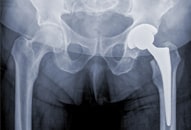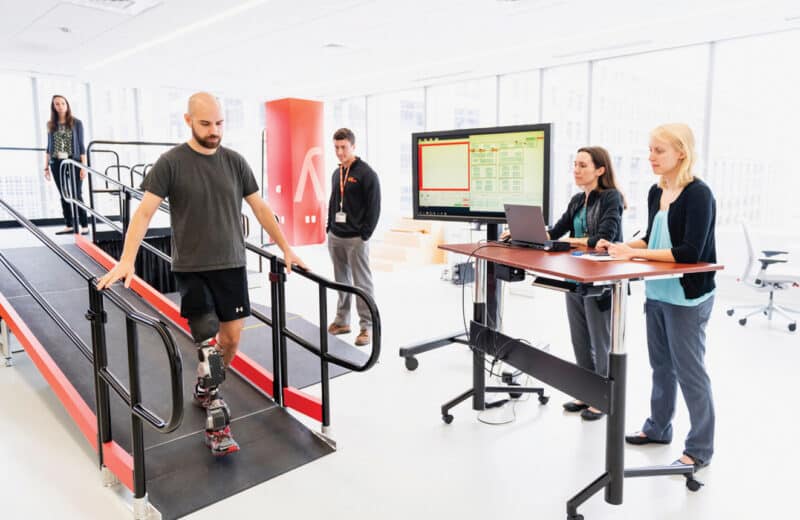More patients are spending less time recovering from joint-related surgeries
By Nancy Maes
Ron Allen was born with an improperly formed hip joint. While the problem didn’t stop him from going to college on an athletic scholarship, it was causing him such excruciating pain that by age 40, he opted for replacement surgery on his left hip. It was 1988, and the outlook wasn’t ideal.
“Back then, the definition of a successful surgery was to allow the patient to walk without a limp and go up and down stairs, which, for someone like me, who considered himself an athlete, wasn’t very consoling,” says Allen, a professor of law at Northwestern University.
After undergoing the procedure, Allen met with others who were facing similar prognoses. “We decided to push the envelope and found that the orthopedic community was under-estimating what you could do with these prosthetic joints,” Allen says. He was exceeding recovery expectations and soon engaging in sporting activities such as tennis, so in 1993, he had his other hip replaced.
“[After] the first [hip replacement], I spent nine days in the hospital. The second time it was more like two days,” he says. “The pain management has gotten astronomically better. My right hip has been essentially… normal since the day I had it done. I still play tennis, though I don’t sprint [around the court much].”
Dr. S. David Stulberg, an orthopaedic surgeon at NorthShore University HealthSystem and co-director of Operation Walk Chicago, performed Allen’s surgeries and says the outcome for today’s patients is far more optimistic.
“Today we use the less invasive posterior approach to hip replacement surgery, which gets people up and going faster and with less pain. We tell patients they will be in physical therapy for about six weeks, depending on how disabled they were before surgery. Patients can ride an exercise bicycle within a week to 10 days and can go back to a desk job within two to three weeks. Once they are walking without a limp, patients are allowed to do anything they want—yoga, golfing, downhill skiing. Our goal is to have them forget they have a hip replacement.”
Stulberg points out that patients undergoing knee replacements can return to normal walking patterns in two to three weeks but that they may need to remain on pain medication for about three weeks, as the knee must be bent and straightened frequently to regain flexibility.
“The rehab for getting flexibility back and, to a lesser extent muscle strength back, [includes] pain management programs [that] continue to be modified and improved. Some technical developments in instrumentation and implants, which are more customized for knee surgery, [also] seem to be associated with [a] more rapid return to function.”
Minimally invasive hip and knee joint replacement surgery is also available. Dr. Richard Berger, an orthopedic surgeon at Rush University Medical Center and a pioneer in minimally invasive hip and knee replacement surgery techniques, points out that only three out of 10 people who would benefit from hip or knee replacement surgery and have insurance to cover the procedure actually seek treatment.
“They are apprehensive about the [results], so [end up enduring] weeks, months and years of disabling pain. They’re afraid of being [permanently] disabled and not being able to work during the recovery period.”
Roughly 60 percent of Berger’s hip and knee replacement surgeries are performed as outpatient procedures, as muscles, tendons and ligaments do not have to be cut. The majority of these patients return home the same day, while others go home the following day.
60-year-old Chicagoan Kathy Mattson, a cashier at Trader Joe’s, does not have fond memories of the traditional knee replacement she underwent for pain in her right knee in 2009. “They cut tendons and muscles, and I was in the hospital for six days. I now have scars that are long and wide on both sides of my knee,” she says. “I worked very hard on my physical therapy, but to this day, that knee still hurts when I walk up and down stairs.”
In June 2012, Berger performed a less invasive knee replacement on Mattson’s left knee. “The difference between the last time…and this time is so amazing,” she says. “I got rid of my cane after a week. My left knee doesn’t hurt going up and down stairs.” She was able to return to work a month earlier than expected.
Mark Workman, another of Berger’s patients, started having arthritis in his left hip when he was in his early 40s. He controlled the pain by losing weight and taking prescription drugs until the problem began to affect his sleep and concentration. Workman had considered traditional surgery but was deterred by a predicted recovery period of 12 to 13 weeks. He eventually decided to undergo minimally invasive surgery with Berger.
“I went home the day of surgery and only took three days off from work,” he says. “At the 10-day mark, I took a driving trip to Iowa and the following week went on an airplane trip. It’s been five years since surgery, and I can do anything I want to, and I feel no pain.”
No matter which route you choose to go, Allen advises researching all your options independently before making a decision about what’s best for you. “Don’t [automatically] accept what a doctor says about a procedure. Do your homework and investigate it yourself,” he says. They’re your joints, after all. [email_link]
Published in Chicago Health Winter/Spring 2013













